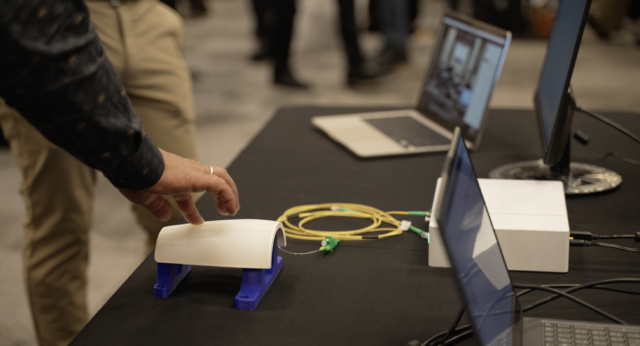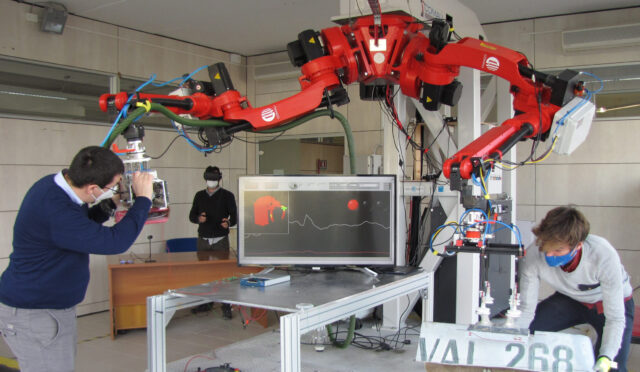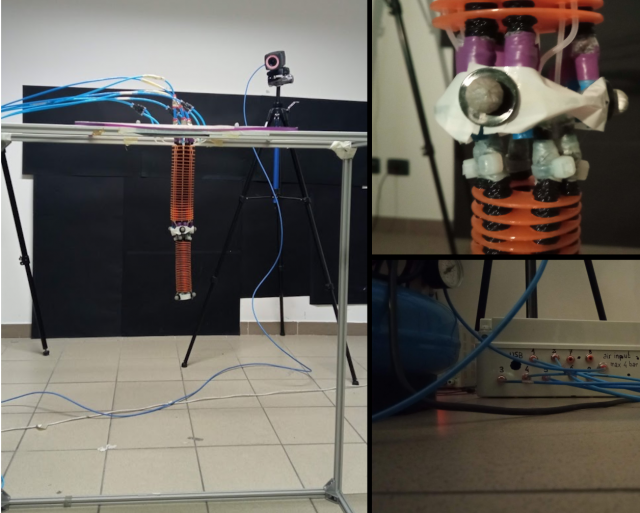HomeRobotic Database - Robotic platform | TERRINet

Electric Car Testbed
The electric car testbed consists of four controlled drives directly connected to the axes of a Roading Roadster Electric car. Both the car drive and other components, as well as the external torque applied to the axes, can be controlled, while the complete state of the car sensors is registered. The station can be used to simulate desired driving conditions and evaluate the performance of wheel drive control algorithms in fully-controlled, reproducible environment. Moreover, the station contains an augmented reality system, which can be used to control the car in a life-like way and allow safe testing of autonomous driving solutions.
Key features:
- Regulations: speed control / torque control / driving load simulation
- Power electronics: Sinamics S120-CM
- Power electronics: 4 inverter modules from common DC link 260kW feed/recovery power
- Vehicle test bench, for testing dynamic driving behavior with real environmental conditions by means of driving simulation
- Engine test bench, for testing drive components and powertrain systems
Possible applications:
- Analysis of the human driver behavior in a highly-controllable, repeatable way
- Different levels of abstraction, from the low-level controllers of the car components (e.g. slipping control systems), up to monitoring driving control of the entire vehicle
Technical specifications
| Torque: | 1500 Nm / 2100 Nm (overload S6-40%) |
| Shaft Power: | 80 kW / 170 kW (overload S6-40%) |
| Maximum speed: | 3000 RPM |
| Dimensions: | Maximum weight 3000 kg, Wheelbase of 1,2-2,0 m, Gauge of 1,5-4,0 m, Maximum vehicle height 2 m |
| Mechanics (3): | Direct connection to wheel hub, thus highly dynamic measurements possible |
| Mechanics (2): | Realizable steering angle: ±18° |
| Mechanics (1): | Mechanical compensation of steering angle and tire drop over stable articulated arm construction and support bearing |
| Drive Technology (1): | 3~asychronous machine |
| Drive Technology (2): | Moment of inertia approx.: 1.0 kgm2 (corresponds to that of a tire) |
| Weight: | approx. 1700 kg |
| Noise: | about 93 dB (A) |
Access information
| Corresponding infrastructure | Technical University Munich Robotics and Embedded Systems |
| Location | Boltzmannstraße 3, |
| Unit of access | Working day |
Access history
EV-DSIM - Driving simulator enhancement based on the measurements offered by the electric car testbed
Csaba Antonya
The aim of this research project is to connect the Electric Car Testbed of the Technical University of Munich (TUM) to an existing driving simulator of the Transilvania University of Brasov (UTBv). The purpose of this connection is to test the real-time driving of an electric car based on measured data offered by the testbed. The benefit of the connection is that the virtual car of the driving simulator is enhanced by measured and validated data. This connection can be used to simulate driving conditions, evaluate the performance of wheel drive control algorithms in scenarios when the user can be aware of the dynamic feedback (movement) of the car. Research questions are related to the development and validation of the dynamic model of the vehicle based on the measurement offered from the testbed of the electric car, and regarding the data transfer to and from the testbed and the simulator.
Testing of virtual cars in multi-modal virtual environment is an important step in the validation process of new concepts and technologies. The measured data obtained from the Electric Car Testbed of the TUM is going to validate the dynamic model of the vehicle of the existing driving simulator of the UTBv. The connection between the TUM testbed and the UTBv simulator will lead to the possibility to real-time testing and driving of virtual cars based on measured data offered by the TUM testbed. The new UTBv driving simulators will provide a virtual driving environment for this Roding Roadster electric car, resembling real driving conditions. This environment is opening the doors for powerful virtual prototyping and testing tools for both new electric car configurations and analyzing driver behavior in a safe environment.








